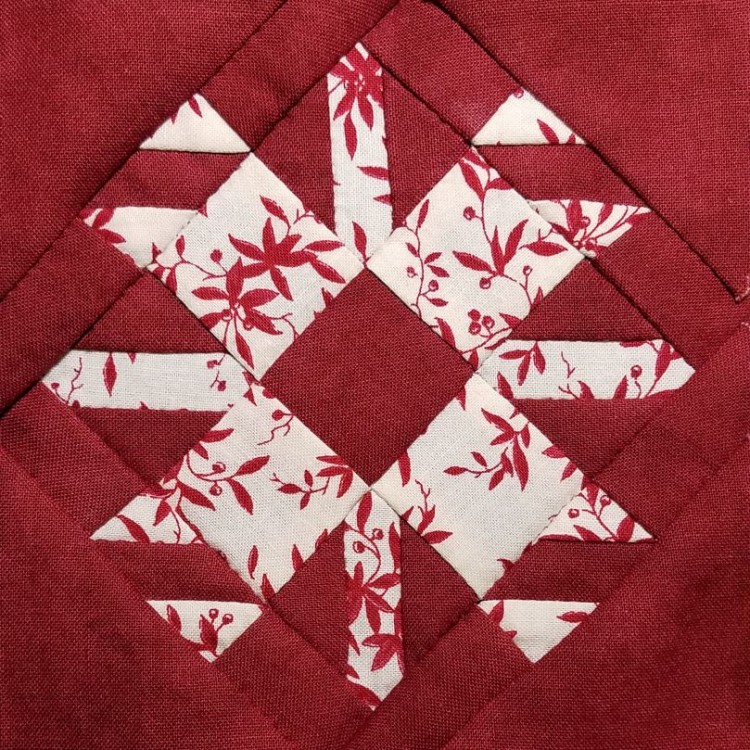I had intended to do one more block with curved pieces, but now that I’m no longer doing multiple similar blocks in an arty series, I want to mix it up to alleviate boredom.
Also, I figure if I run out of beginner blocks, I might not want to finish the quilt, so I should hold more of those back; that way I can sprinkle in a beginner block whenever I need motivation and/or a confidence boost.
So, I give you this decidedly un-curvy advanced block.
While the block is un-curvy, the pattern threw a curveball at me, in the form of more unnecessary tiny triangles. For those four strips of leafy fabric that are pointed at each end, the pattern called for creating one of the points (not both, mind you, just the outside one) by sewing a tiny triangle on to the end of the strip. On the other end of the strip, you just cut the strip out with a pointed end, but for some reason they didn’t want you to do that on the outside end.
I just didn’t see the point (pun totally intended) in adding more seam allowance bulk at the outside point. Once again, I opted to consolidate pieces and eliminate seams, so I didn’t have those tiny triangles to deal with. As a bonus, it made for 4 fewer pieces in this many-pieced block.
In my last block I surpassed the 1,000 piece mark. That’s an awful lot of pieces to sew together by hand. I don’t know how I let this go uncelebrated at the time. I guess I had a lot to talk about already in that post. You can always keep track of my piece count on The Progress page. I love these kinds of measurements as motivational tools.
The original 1860s quilt made by Jane Stickle has the number of pieces embroidered in one corner of the quilt. My number is unlikely to match hers, because I keep consolidating pieces, but that’s okay. I’m apparently not that much of a stickler for historical accuracy in my quilts.
Also, it doesn’t appear that Jane’s quilt even had those tiny triangles. I don’t get why the pattern maker would add them in. It just seems like it would add bulk without adding any advantages (like making the assembly easier).
Once I eliminated the tiny triangles, the assembly was not too difficult, just time-consuming. With all these advanced blocks, I may need to change my goal from three blocks per month to two.
It is frustrating that some of the seams in the finished block look a little bit wobbly. This is because the narrow red leaves in the white fabric match the red of the background fabric pretty closely, so wherever there is a narrow leaf right next to a seam, it makes it look like the leaf is part of the red fabric piece … and like I couldn’t sew the seam straight.
Paulette had three yards of this fabric and several blocks slated to use it. I hope this wobbly optical illusion isn’t going to be a problem on the other blocks that I’ll be making with this fabric.
We’ll have to wait a while to see, because I’ve realized that I haven’t repeated any fabric in the first 57 blocks, so now I feel compelled to use each fabric at least once before I start repeating fabrics. If a piece count is motivational, why not a fabric count?
As usual, I had planned ahead at least the next 10 blocks to do, but now I want to mix it up more – not just the fabric, but also in terms of difficulty and style. So, next I’m going to challenge myself with something completely different – isosceles triangles. 18 of ’em.

Your block looks beautiful, it looks so neat. Also, a great idea to have a pieces count, now I wish I did that as well. It is strange though the pattern has more pieces than the original Dear Jane, especially considering Jane used scraps in times of scarcity so it makes more sense for her to use even the tiniest pieces.
This block tricked me many times because I kept sewing the tiny pieces the wrong way so I had to rip them out many times. Not a very good idea with pieces this tiny… But it worked all out in the end!
Yes, I’m not sure why the pattern sometimes doesn’t match the original. My best guess is sometimes more seams are added because it makes sewing by machine easier … and maybe sometimes seams are removed to eliminate extra seam allowance bulk.
Another advantage to eliminating extra seams is that there are fewer seams to rip out when I sew them wrong!